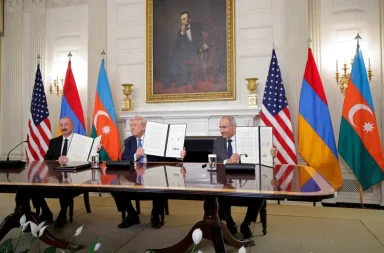by David Bishop
Armenia’s ruling Civil Contract party has declared the creation of a “Fourth Republic” as its new strategic goal, a move that has sparked sharp debate over the country’s political future.
The announcement came during the party’s Seventh congress, where delegates unanimously approved a declaration outlining sweeping plans to restructure the state. Nikol Pashinyan framed the initiative as a modernization effort, though critics argue it amounts to dismantling Armenia’s existing institutions. Among several declared core party objectives for the upcoming 2026 Armenian parliamentary elections, the new Civil Contract party manifesto proclaims in all-capital letters “THE ESTABLISHMENT OF THE FOURTH REPUBLIC OF ARMENIA AS A FUTURE STRATEGIC ACTION.” This is the only policy objective in the new party platform to be emphasized with capital letters.
Other notable policy announcements include “welcoming the peace established between the Republic of Armenia and the Republic of Azerbaijan”; as well as reforming Armenia “based on the ideology of the Real Armenia.” A political slogan describing the Civil Contract platform as “Real Armenia” leaves much confusion as to what exactly is “real” Armenia as opposed to non-real or fake Armenia. Apparently the ideology of the Civil Contract party is what counts as Real Armenia. Though this phrase is obviously nebulous, it has recently been much-trumpeted in pro-Pashinyan media, after appearing to have been first wheeled out by propagandists in recent months.
According to the Civil Contract party’s plan published at the Seventh Congress, the party aims to secure another five-year mandate in the 2026 parliamentary elections and then hold a nationwide referendum on a new Constitution. The first step is of course winning the 2026 elections, and this would pave the way to a new Armenian constitution. Notably, Armenian constitutional reform has long been a core demand of Azerbaijan against Armenia, as Azerbaijan seeks not only to conquer Artsakh as they have now done, but even to force constitutional amendments in Armenia prohibiting Armenia from ever trying to return to Artsakh again. Thus the complete and unquestionable triumph of Azerbaijan is one of the objectives of Armenian constitutional reform.
If the constitutional reform is enacted by Civil Contract after they secure power in the 2026 elections, the new constitutional Armenia would be called the Armenian Fourth Republic by Pashinyan and his party. The logic of this, why it is the “fourth”, is seen by examining Armenian history. The First Republic was of course the briefly independent Armenian republic that existed from 1918-1920 before its partition between the Soviets and Turkey. The Second Republic refers to the Armenian Soviet Socialist Republic that existed throughout the Soviet era within the USSR. Finally, the Third Armenian Republic refers to the independent Republic of Armenia that exists today, since the dissolution of the Soviet Union in 1991. Thus, by proclaiming a new Fourth Republic, Pashinyan’s platform emphasizes that the planned constitutional reforms should be of such a significant nature that the very republic in which Armenia existed today will be replaced, and an entire era of Armenian history will come to an end. In connection with this, another pillar of the Seventh Congress declaration is that the new Armenia will be forced to “analyze the history of the Third Republic”. Essentially, they thus announce that the current Armenian era must end, and its history needs to be analyzed in order to identify all of the mistakes of current Armenian society. After all, an entirely new Armenia must be built, learning from the current Armenia’s “mistakes”. Truly significant societal transformation is evidently planned by Civil Contract.
The third listed point in the Civil Contract platform is that the envisioned “Fourth Republic” will be “rooted in the 1991 Alma-Ata Declaration” and will affirm Armenia’s internationally recognized borders of 29,743 square kilometers, a territorial definition that expressly excludes Artsakh.
The declaration also emphasizes Armenia’s ambition to “intensify efforts toward EU membership” while pursuing a “balanced foreign policy.” Analysts note that, despite calling this policy “balanced”, such a shift would effectively sever ties with the Eurasian Economic Union (EAEU) and the Collective Security Treaty Organization (CSTO), and significantly reduce Armenia’s long-established relations with Russia, among other states. This is clearly part of a campaign to reorient Armenia to the West, placing Armenia within a US/EU sphere of influence. Movement in the Western direction is already obvious from the Pashinyan government, as seen in the acceptance of the American peace plan between Armenia and Azerbaijan and the introduction of the “Trump Route”, which satisfies even more of Azerbaijan’s demands. So far, orientation to the West appears to just mean more Azerbaijani initiatives being pushed on Armenia.
Balance with Russia would be hardly possible in such an arrangement, given the traditional insistence of Western foreign policy on an “either with us or against us” doctrine. The fact that an overwhelming portion of Armenia’s foreign trade is with Russia would be of no consequence to Western elites, or apparently to Civil Contract. Friendliness or even neutrality with Russia is intolerable to the monolithic Western foreign policy bloc, which has even threatened sanctions against Georgia recently just for maintaining some degree of neutrality towards Russia.
Pashinyan further presented the initiative as a mandate to secure peace with neighboring states. Opposition voices, however, contend that this represents capitulation to Turkey and Azerbaijan, particularly in the wake of Armenia’s military defeat in Nagorno-Karabakh (Artsakh). They argue the push for a new Constitution echoes Baku’s demands, with Azerbaijani leaders refusing to finalize a peace deal without it. Indeed, Aliyev has repeatedly insisted on Armenian constitutional reform as a prerequisite for a peace treaty with Armenia. Pashinyan’s plan is to give them exactly what they want.
For Pashinyan’s critics, the “Fourth Republic” project is less about reform and more about completing what he began in 2018: dismantling Armenia’s sovereignty under the banner of “democratic” reforms.


